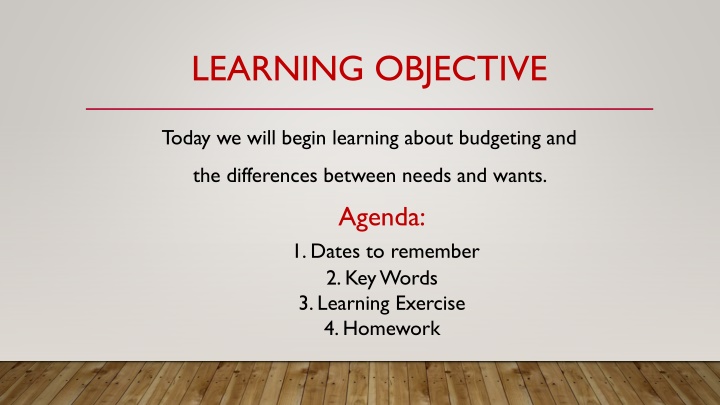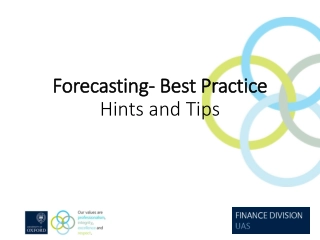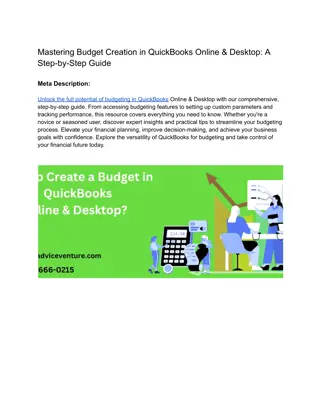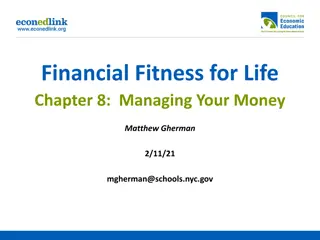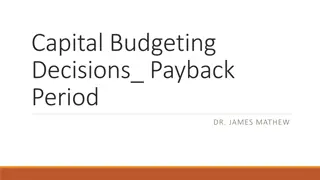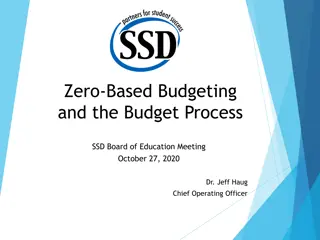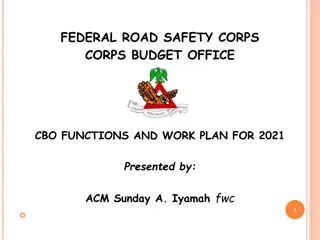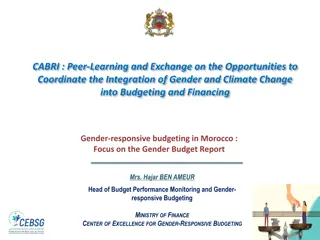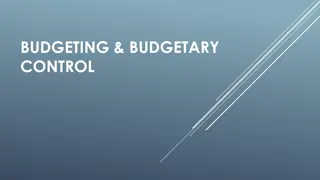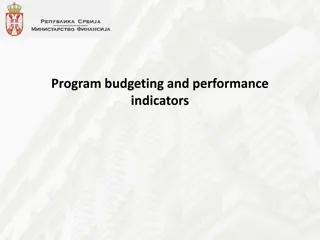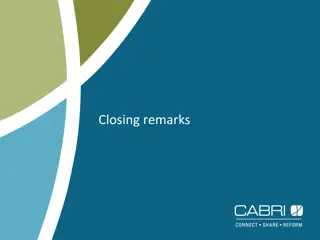Introduction to Budgeting and Needs vs Wants
Begin learning about budgeting, needs vs wants, and financial management. Explore the concepts of gross income, net income, taxes, budget planning, debt, loans, and interest. Understand the importance of saving and differentiating between essential needs and discretionary wants through practical examples.
Download Presentation

Please find below an Image/Link to download the presentation.
The content on the website is provided AS IS for your information and personal use only. It may not be sold, licensed, or shared on other websites without obtaining consent from the author.If you encounter any issues during the download, it is possible that the publisher has removed the file from their server.
You are allowed to download the files provided on this website for personal or commercial use, subject to the condition that they are used lawfully. All files are the property of their respective owners.
The content on the website is provided AS IS for your information and personal use only. It may not be sold, licensed, or shared on other websites without obtaining consent from the author.
E N D
Presentation Transcript
LEARNING OBJECTIVE Today we will begin learning about budgeting and the differences between needs and wants. Agenda: 1. Dates to remember 2. Key Words 3. Learning Exercise 4. Homework
THIS WEEKS ANNOUNCEMENTS Tues. Sept. 11th- Mandatory 9th Grade Parent Night in the Cafeteria 6-7pm Thurs. Sept. 13th- Mandatory 10th Grade Parent Night in the Cafeteria 6-7pm Thurs. Sept. 13th- Student Council s 1st meeting in the Library 4:15-5pm Buy your BISD Hope Strong t-shirts for $15. Order forms are in the front office. Please give money to Mr. Gordon
KEY WORDS This Class Gross Income- Total pay before taxes are deducted. Net Income- Pay after taxes are deducted. Taxes- money a person has to pay to local, state, or federal government for public services, such as roads, police, military, schools, etc. Last Class Budget- a written plan to spend your money. Debt- money that is owed or due. Loan- money that is borrowed and will need to be repaid, typically with interest, ex. school loan, mortgage (loan to purchase a house), or car loan. Interest- the charge for borrowing money. For example, for a $100 loan if the interest is 6%, you would need to pay back the $100 plus $6 for the loan.
BUDGETING EXAMPLE Let s look at budgeting. As discussed last class, a budget tracks where your money is going, so that you do not spend more than you make, and allows you to save for something big, such as a car or college. Here is an example of a good budgeting idea- the 50/30/20. 50% for needs such as car payment, car insurance, gas, school books, cell phone. 30% for wants such as eating out, going to the movies. 20% for financial goals such as saving for college or a car.
BUDGETING EXAMPLE Here is a budget I created for a high school student using the 50/30/20. This student works 20 hours a week at HEB, making $10 an hour, his parents pay for his car, housing, and groceries, although he has to pay for his car insurance and gasoline, and he is trying to save for college. Texas Reality Check Gross Income $800 20 hours x 10 hours x 4 weeks =$800 Taxes ($200)Most people plan on taxes taking 25% of income Net Income $600 Savings ($120)20% of $600= $120 $480 is left. Fun Car insurance Gasoline Cell Phone ($180)30% of $600= $180 $300 is left. Eating out, spending time with friends, senior trip. ($100)Car insurance for a high school is expensive. $200 is left ($30)$170 is left. ($60)$110 is left.
BUDGETING EXAMPLE This student had $110 left, which he could add to his college savings or pay for something else. Of course, he does not have to pay for rent, groceries, or a car payment.
INSURANCE Required Car Insurance- Liability Health Insurance- currently allowed to be on parents plan until age 26 Homeowner s Insurance if you have a mortgage Not Required Dental Vision Insurance Car Insurance- Comprehensive Life Insurance Burial Insurance Rental/ Home Insurance Flood Insurance
HOMEWORK Keep tracking your expenses. Using what you have learned, create a simple budget. What would you save money for? Next week, we will discuss setting goals.
